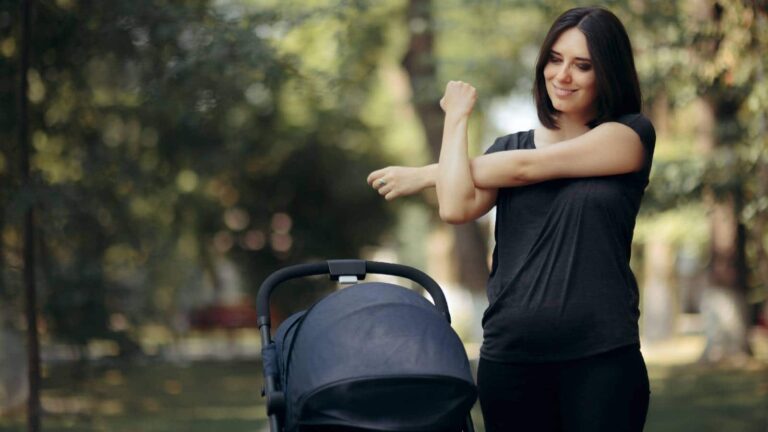
[ad_1]
Motherhood is said to be one of the most beautiful experiences in a woman’s life. The journey from conception till the birth is quite emotionally and physically challenging. We put most of our efforts to have a healthy and fit pregnancy. But it’s not just sufficient. Putting efforts to stay active and healthy for new mother after delivery is also important.
The post-delivery phase is divided into two.
1. The immediate postpartum phase which starts from delivery of baby till six weeks.
2. The later postpartum phase which starts from six weeks to one year.
So, it is important that a newly delivered mother starts with her physical activities from her immediate postpartum delivery phase. You should not rush to get a flat belly post pregnancy.
Many women, in the postpartum phase, do not get proper education about which activities to start, when to start with exercises, how to maintain the optimal posture which leads to lack of activities in them and delays their recovery.
Benefits of postpartum exercises for a new mother:
Starting with immediate exercises post-delivery will help the mother in the following ways:
* It helps to elevate the mood
* It helps to improve energy levels
* Maintains and improves strength of abdominal muscles, back muscles, pelvic floor muscles
* Aids in reducing extra weight gained during pregnancy
* It helps to improve cardio-respiratory fitness
* Helps to cope with postpartum depression and anxiety
* Helps to get sound sleep.

When should you begin postpartum exercises?
If you have delivered vaginally or you have under gone cesarean section, according to American College of Obstetrics and gynecology (ACOG), you can start doing exercises post-delivery as soon as possible. Once you start feeling stable, around the second or third day of delivery, you can start doing the exercises. That will include basic movements of your body to maintain overall mobility of your body.
* Post delivery, after 2 weeks, you should have a consultation with a women’s health expert physiotherapist You will undergo a check for abdominal muscle separation and strength of pelvic floor muscle.
As throughout a pregnancy, a baby keeps growing inside the mother’s belly. it can cause stretching of abdominal muscles. They can get separated from each other. This condition is called diastasis recti. These muscles gives stability to your spine. But due to muscle separation, spinal stability gets compromised, and you may experience back pain, looseness around abdomen and difficulties in daily activities due to lack of support around abdominal and lower back area.

Pelvic floor muscles are around your waist or pelvic area. These help to have optimal urine function, motion function and is important for sexual health also. Throughout pregnancy, in order to hold the baby in its position, these muscles undergo a lot of strain. So after delivery, you may experience urine leak with strenuous activities, difficulties in controlling urine or motion once you get urge.
You may experience upper or middle back pain due to a long time of sitting or being in a wrong posture for breastfeeding. So, it is important for you to visit a physiotherapist to have overall assessment. Based on that, they will teach you exercises that will be focusing on core activation, pelvic floor strengthening and strengthening of back extensor muscles, stretching and strengthening of muscles in and around your upper back.
Along with the exercises, it is important to have awareness about your body posture. Maintaining optimal posture while breastfeeding will again help to prevent aches and pains of your upper back and lower back.
A combination of deep breathing exercises, stretching and strengthening exercises along with postural correction will help the newly delivered mother to have optimal physical health which in turn helps to have fast and healthy recovery.
What types of postpartum exercises are fit for a new mother?
1. Walking
You can start with walking for about 15 to 20 minutes a day. According to ACOG, you should do at least 150 minutes of aerobic exercises with moderate intensity.
Exercise around 5 times a week for 30 minutes or do 10 minutes of exercises every day.

2. Weight Training
You can do weight training twice or three times a week.
If you are an athlete, you can do high intensity workouts. But before starting with any exercise, it is advisable that you should have a consultation with the physiotherapist.
In order to start with moderate intensity exercises or any weightlifting or jogging type of aerobic activity, you have to wait for 6 weeks in case of vaginal delivery and 12 weeks for cesarean section.
These will be advised only after a check-up of your separation of abdominal muscles, strength and endurance of your pelvic floor muscles and strength of back muscles.
Your physiotherapist will guide you like which exercises you can start with, which exercises to avoid and how to progress with your exercise protocols. You can also choose the options like postnatal yoga, postnatal Pilates, weight training or stationary aerobic activities once you get clearance from your physiotherapist.
When should discontinue with postpartum exercises?
If you experience sudden pain or discomfort around your abdominal area, chest area or if you experience any symptoms during or after doing exercises, those are not usual then you should contact to physiotherapist.
Do appropriate exercises, have a nutritious and balanced diet, drink plenty of water and stay active will help you recover well and will help you to return to pre-pregnancy phase of life.
[ad_2]
Source link